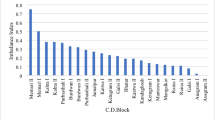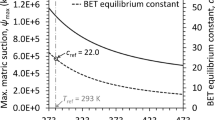Abstract
Mercury intrusion porosimetry (MIP) is a simple and fast way to obtain the pore distribution of soil and can be used to estimate the soil-water characteristic curve (SWCC). In previous studies, soil was assumed to be a perfect wettability material, and the contact angle (CA) of the soil-water interface was taken as zero in the SWCC prediction method. However, the CA has proved to be much greater than zero even for hydrophilic soils according to some soil wettability experiments, and it has a significant effect on predicting the SWCC. In this research, a method for predicting the SWCC by MIP, which takes the CA as a fitting coefficient, is proposed. The pore size distribution curves are measured by MIP, and the SWCCs of two loess soils are measured by pressure plate and filter paper tests. When the CA is taken as 70° and 50° for the wetting and drying process, respectively, the SWCCs predicted by the pore size distribution curves agree well with the measured SWCCs. The predicted suction range of the proposed method is 0–105 kPa. The consistency of the results suggests that utilizing the MIP test to predict the SWCC with a proper CA is effective for loess.
Similar content being viewed by others
Abbreviations
- CA:
-
Contact angle
- CRM:
-
Capillary rising method
- FPT:
-
Filter paper test
- MIP:
-
Mercury intrusion porosimetry
- PPT:
-
Pressure plate test
- PSD:
-
Pore size distribution
- SDM:
-
Sessile drop method
- SWCC:
-
Soil-water characteristic curve
- WPM:
-
Wilhelmy plate method
- d :
-
Pore diameter
- m h :
-
Slope of the w2 — t curves of n-hexane
- m w :
-
Slope of the w2 — t curves of water
- n :
-
Porosity of the sample
- P m :
-
Intruding pressure of MIP
- T m :
-
Surface tension of the mercury phase
- T w :
-
Surface tension of the water phase
- V a :
-
Real air volume
- V a,m :
-
Air volume measured with MIP
- V m :
-
Mercury volume
- V max :
-
Nondetected pore volume (pores that are too large
- V max :
-
to measure with MIP)
- V min :
-
Nonintruded pore volume (pores are too small for mercury to intrude with MIP)
- V s :
-
Soil solid volume
- V t :
-
Real total soil volume
- V t,m :
-
Total soil volume measured by MIP
- V w :
-
Intruded water volume
- w :
-
Increased mass at CRM test
- α m :
-
Contact angle at the air-mercury-soil interface
- α w :
-
Contact angle at the air-water-soil interface
- α wd :
-
Drying contact angle at the air-water-soil interface
- α ww :
-
Wetting contact angle at the air-water-soil interface
- η h :
-
Dynamic viscosity of n-hexane
- α w :
-
Dynamic viscosity of water
- θ w :
-
Volumetric water content
- ρ d :
-
Real soil density
- ρ d,m :
-
Soil density measured by MIP
- ρ h :
-
Density of n-hexane
- ρ w :
-
Density of water
- σ lv,h :
-
Surface energy of n-hexane
- σ lv,w :
-
Surface energy of water
- ψ :
-
Matric suction
References
Bachmann J, Woche SK, Goebel MO, et al. (2003) Extended methodology for determining wetting properties of porous media. Water Resources Research 39(12):11–1–11–14. https://doi.org/10.1029/2003wr002143
Diamond S (1970) Pore size distributions in clays. Clays and Clay Minerals 18(1):7–23. https://doi.org/10.1346/CCMN.1970.0180103
Dijkstra TA, Rogers CDF, Smalley IJ et al. (1994) The loess of north-central China: Geotechnical properties and their relation to slope stability. Engineering Geology 36(3–4): 153–71. https://doi.org/10.1016/0013-7952(94)90001-9
Feda J (1988) Collapse of loess upon wetting. Engineering Geology 25(2–4):263–289. https://doi.org/10.1016/0013-7952(88)90031-2
Fu H (2018) Study on Engineering Characteristics of Loess in Middle Pleistocene. Master’s thesis, Chang’an University. Xi’an, China (In Chinese). CNKI:CDMD:2.1018.791893
Gao GR (1979) Study of the microstructures and the collapse mechanism in loess soil from Lanzhou. Journal of Lanzhou University (6):123-134 (in Chinese). https://doi.org/10.1360/csb1980-25-20-945
Gao GR (1980) The microstructures of loess in China. Chinese Science Bulletin (20):945-8 (in Chinese). CNKI:SUN:KXTB.0.1980-20-010
Goebel MO, Bachmann J, Woche SK (2008) Modified technique to assess the wettability of soil aggregates: Comparison with contact angles measured on crushed aggregates and bulk soil. European Journal of Soil Science 59(6):1241–1252. https://doi.org/10.1111/j.1365-2389.2008.01073.x
Hajnos M, Calka A, Jozefaciuk G (2013) Wettability of mineral soils. Geoderma 206:63–69. https://doi.org/10.1016/j.geoderma.2013.04.019
Kuila U, Prasad M (2013) Specific surface area and pore-size distribution in clays and shales. Geophysical Prospecting 61(2):341–362. https://doi.org/10.1111/1365-2478.12028
Lei XY (1983) Type of the loess microtextures in Xi’an district. Journal of Northwest University (4):56-65 (In Chinese). CNKI:SUN:XBDZ.0.1983-04-009
Lei XY (1987) Pore types of loess soils in China and its collapsibility. Science in China: Series B (12):1310-6 (in Chinese). CNKI:SUN:JBXK.0.1987-12-008
Li P, Vanapalli S, Li TL (2016) Review of collapse triggering mechanism of collapsible soils due to wetting. Journal of Rock Mechanics and Geotechnical Engineering 8(02):256–274. https://doi.org/10.1016/j.jrmge.2015.12.002
Li P, Li TL, Vanapalli SK (2018) Prediction of soil-water characteristic curve for Malan loess in Loess Plateau of China. Journal of Central South University 25(2):432–447. https://doi.org/10.1007/s11771-018-3748-1
Liu SY, Yasufuku N, Liu Q, et al. (2013a) Physically based closed-form expression for the bimodal unsaturated hydraulic conductivity function. Water Science and Technology 68(2):328–334. https://doi.org/10.2166/wst.2013.229
Liu Z, Yu X, Wan L (2013b) Influence of Contact Angle on Soil-Water Characteristic Curve with Modified Capillary Rise Method. Transportation Research Record 2349:32–40. https://doi.org/10.3141/2349-05
Lu N and Likos WJ (2004) Unsaturated Soil. Mechanics New York, PA: John Wiley & Sons, Inc. pp 449–452. 10.1.1.57:8888/dspace/handle/hau/5179
Masrouri F, Bicalho KV, Kawai K (2008) Laboratory Hydraulic Testing in Unsaturated Soils. Geotech Geol Eng 26(6): 691–704. https://doi.org/10.1007/s10706-008-9202-7
Monroy R, Zdravkovic L, Ridley A (2010) Evolution of microstructure in compacted London Clay during wetting and loading. Géotechnique 60(2)105–119. https://doi.org/10.1680/geot.8.P.125
Muñoz-Castelblanco JA, Pereira JM, Delage P, Cui YJ (2012) The water retention properties of a natural unsaturated loess from Northern France. Geotechnique 62(2):95–106. https://doi.org/10.1680/geot.9.P.084
Ng CWW, Sadeghi H, Hossen SB, et al. (2016) Water retention and volumetric characteristics of intact and re-compacted loess. Canadian Geotechnical Journal 53 (8): 1258–1269. https://doi.org/10.1139/cgj-2015-0364
Penumadu D, Dean J (2000) Compressibility effect in evaluating the pore-size distribution of kaolin clay using mercury intrusion porosimetry. Canadian Geotechnical Journal 37:393–405. https://doi.org/10.1139/cgj-37-2-393
Prapaharan S, Altschaeffl AG, Dempsey BJ (1985) Moisture Curve of Compacted Clay: Mercury Intrusion Method. Journal of Geotechnical Engineering 111(9):1139–1143. https://doi.org/10.1016/0148-9062(86)90426-2
Romero E, Gens A, Lloret A (1999) Water permeability, water retention and microstructure of unsaturated compacted Boom clay. Engineering Geology 54(1–2):117–127. https://doi.org/10.1016/S0013-7952(99)00067-8
Romero E, Simms P H (2008) Microstructure Investigation in Unsaturated Soils: A Review with Special Attention to Contribution of Mercury Intrusion Porosimetry and Environmental Scanning Electron Microscopy. Geotechnical and Geological Engineering 26(6):705–727. https://doi.org/10.1007/s10706-008-9204-5
Shang J, Flury M, Harsh JB, et al. (2008) Comparison of different methods to measure contact angles of soil colloids. Journal of Colloid and Interface Science 328(2):299–307. https://doi.org/10.1016/j.jcis.2008.09.039
Sills ID, Aylmore LAG, Quirk JP (1973) A comparison between mercury injection and nitrogen sorption as methods of determining pore size distribution. Proceedings of the Soil Science Society of America 37:535–537. https://doi.org/10.2136/sssaj1973.03615995003700040021x
Simms PH and Yanful EK (2001a) Measurement and estimation of pore shrinkage and pore distribution in a clayey till during soil-water characteristic curve tests. Canadian Geotechnical Journal 38(4):741–754. https://doi.org/10.1139/t01-014
Simms PH and Yanful EK (2001b) Predicting soil-water characteristic curves of compacted plastic soils from measured pore-size distributions. Géotechnique 52(4):269–278. https://doi.org/10.1680/geot.2002.52.4.269
Simms P H and Yanful E K (2005) A pore-network model for hydromechanical coupling in unsaturated compacted clayey soils. Canadian Geotechnical Journal 42(2): 499–514. https://doi.org/10.1139/t05-002
Sun DA, Zahng JR, Lv HB (2013) Soil-water characteristic curve of Nanyang expansive soil in full suction range. Rock and Soil Mechanics 34(7):1839–1846 (In Chinese). CNKI:SUN:YTLX.0.2013-07-004
Sun JZ (2005) Loessology (Vol.1) Hong Kong Archaeological society (In Chinese).
Tan T (1988) Fundamental properties of loess from northwestern China. Engineering Geology 25(2–4): 103–22. https://doi.org/10.1016/0013-7952(88)90022-1
Wang M, Kong L, Zang M (2015) Effects of sample dimensions and shapes on measuring soil-water characteristic curves using pressure plate. Journal of Rock Mechanics and Geotechnical Engineering 7(4):463–468. https://doi.org/10.1016/j.jrmge.2015.01.002
Wang M, Pande GN, Kong LW, Feng YT (2017) Comparison of Pore-Size Distribution of Soils Obtained by Different Methods. International journal of geomechanics 17(1):1–6. https://doi.org/10.1061/(ASCE)GM.1943-5622.0000696
Washburn EW (1921) The Dynamics of Capillary Flow. Phys. rev. ser 17(3):273–283. https://doi.org/10.1103/PhysRev.17.273
Woche SK, Goebel MO, Kirkham MB, et al. (2005) Contact angle of soils as affected by depth, texture, and land management. European Journal of Soil Science 56(2)239–251. https://doi.org/10.1111/j.1365-2389.2004.00664.x
Xie WL, Li P, Zhang MS, Cheng TE, Wang Y (2018) Collapse behavior and microstructural evolution of loess soils from the Loess Plateau of China. Journal of Mountain Science 15(08):31–46. https://doi.org/10.1007/s11629-018-5006-2
Xie X (2018) Study on soil-water characteristic curve and pore characteristics of compacted loess. Master’s thesis, Chang’an University. Xi’an, China (in Chinese). CNKI:CDMD:2.1018.792416
Ye YX, Zou WL, Han Z, Liu XW (2019) Predicting the entire soil-water characteristic curve using measurements within low suction range. Journal of Mountain Science 16(05):255–271. https://doi.org/10.1007/s11629-018-5233-6
Zhang LM, Li X (2010) Micro Porosity Structure of Coarse Granular Soils. Journal of Geotechnical and Geoenvironmental Engineering 136(10):1425–1436. https://doi.org/10.1061/(ASCE)GT.1943-5606.0000348
Acknowledgements
The research was supported by the National Natural Science Foundation of China (Program No. 41790442 and No. 41772278).
Author information
Authors and Affiliations
Corresponding author
Rights and permissions
About this article
Cite this article
Li, H., Li, Tl., Li, P. et al. Prediction of loess soil-water characteristic curve by mercury intrusion porosimetry. J. Mt. Sci. 17, 2203–2213 (2020). https://doi.org/10.1007/s11629-019-5929-2
Received:
Revised:
Accepted:
Published:
Issue Date:
DOI: https://doi.org/10.1007/s11629-019-5929-2




